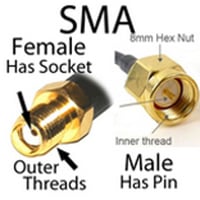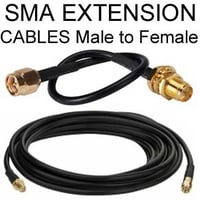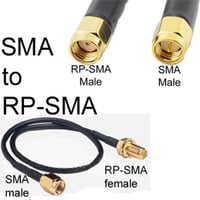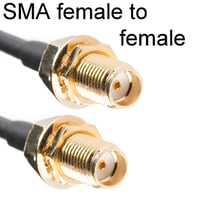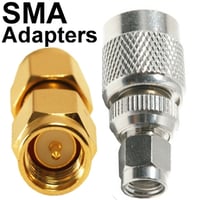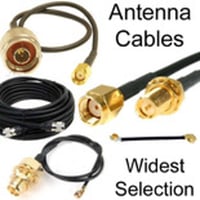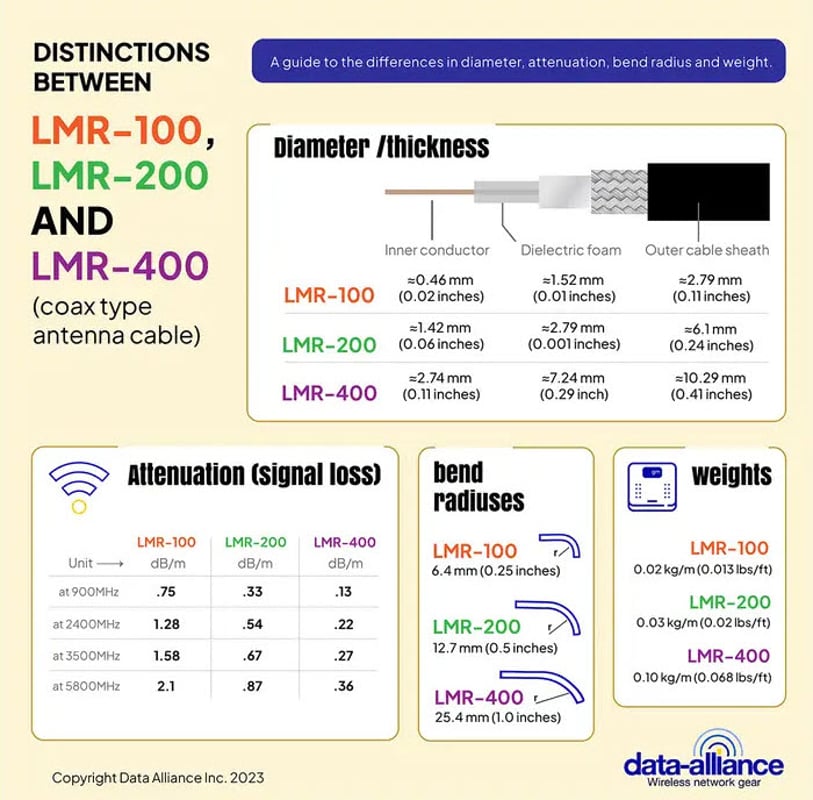SMA Extension Cables
SMA Male to Female Cables for Antennas
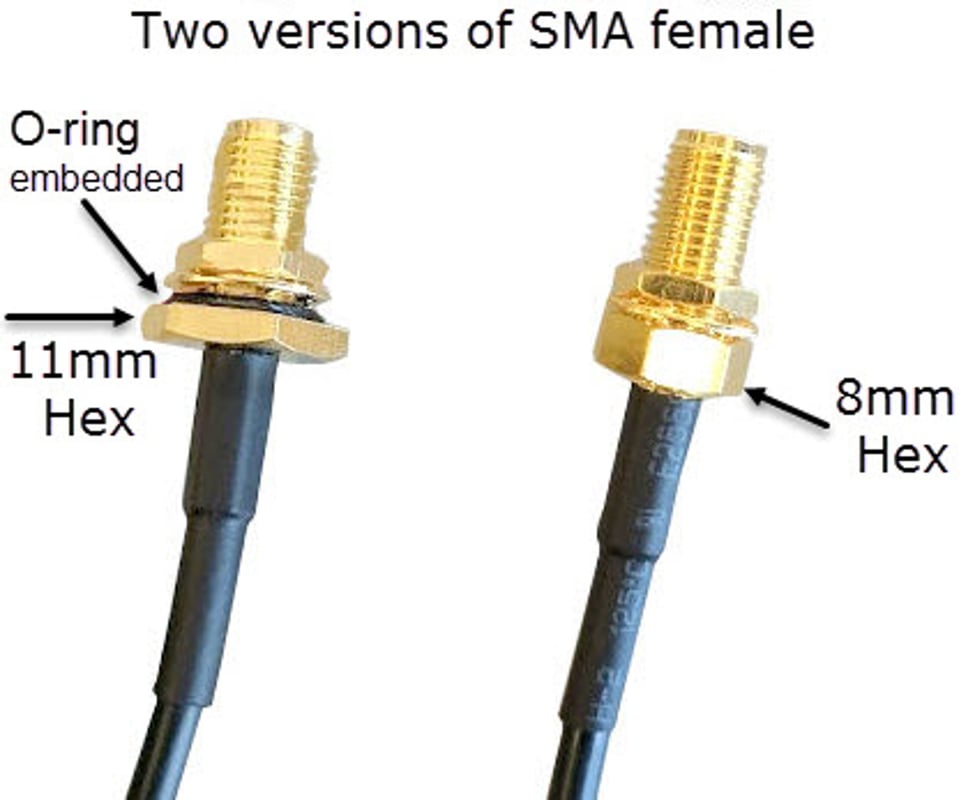 |
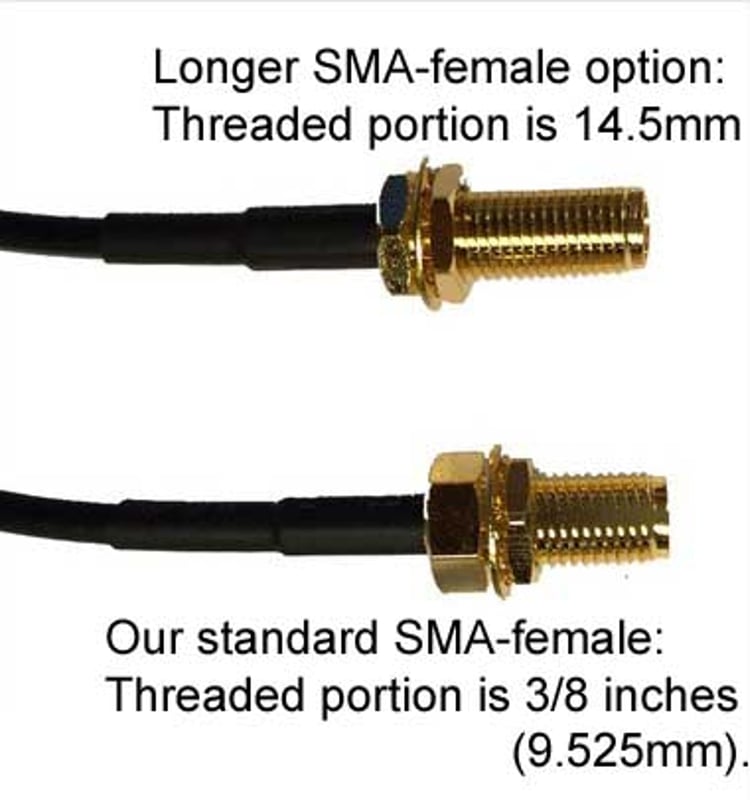 |
| The version of the SMA female connector on the left has an embedded o-ring, together with a wider flange, for more secure protection against intrusion of water and/or dust and dirt. It is available for some of our "stocked" SMA extension cable versions, and others by special order. | The longer SMA-female version (top in photo) has a 14.5mm threaded section. It is available for some of our "stocked" SMA extension cable versions, and others by special order. |
Double-shielded coaxial cables of our SMA extension cables:
LMR-100-equivalent, LMR-200-equivalent & LMR-400-equivalent are double-shielded, low signal-loss coaxial cable types for antenna cables.
Double-Shielded Low-Loss Coaxial Design: A distinguishing feature of Data Alliance's SMA cables is their double-shielded low-loss coax. This design minimizes signal attenuation and interference, ensuring optimal signal strength and clarity over extended distances.
Durability: The meticulous construction of these cables ensures they withstand external pressures, be it environmental or physical.
Compatible Wireless Protocols and Technologies
SMA extension cables are versatile. They support a variety of wireless protocols and technologies. Among them are:
- Wi-Fi (802.11 a/b/g/n/ac/ax)
- Cellular (GSM, 3G, 4G, and upcoming 5G)
- RFID and NFC
- GPS and satellite communication
- Zigbee and Z-Wave
Their universality ensures they integrate seamlessly with a plethora of devices, further reinforcing their essential nature in the wireless ecosystem.
Torque Ratings of SMA Connectors
Torque rating represents the optimal amount of rotational force that can be applied to the cable connectors without damaging them. Typically, the SMA connectors have torque specifications that should be adhered to during installation. Using a torque wrench ensures that the connectors are neither over-tightened nor too loose, which could compromise the signal.
Materials Composition
SMA extension cables are often made of:
- Center Conductor: Typically made of solid or stranded copper.
- Dielectric Insulation: This component separates the center conductor from the shielding, often made of polyethylene or PTFE.
- Shielding: Double-shielded designs typically involve a combination of foil and braided shielding.
- Outer Jacket: Usually crafted from PVC or a similar durable material, it offers protection against external elements.
An SMA Extension Cable is comprised of coaxial cable terminated with SMA male and female connectors. A coax cable with SMA connectors can be used to increase the range of cable, antennas and devices. SMA male to SMA female extension cable is widely available and can be used in most applications where SMA connectors are present. Data Alliance provides SMA extension cables in a range of lengths from 6 inches up to 150 feet, but it is important to know that there will be a certain loss of power with each meter of length. There are varieties of coax cables that have been designed to be 'low-loss'. LMR-100, LMR-200, and LMR-300 are double shielded coaxial cables that are very high quality, low-loss coax cable in part because of double-shielding and superior durability, especially in outdoor environments.
The SMA Connector: The Sub-Miniature Version A connector, known as the SMA connector is a Radio Frequency (RF) and microwave connector designed to attach antennas to coax cables in a variety of RF applications. As its name describes it is sub-miniature as well as semi-precision and offers a strong and durable 50 ohm impedance connection which can conduct frequencies up to 18GHz and beyond.
Structure and Component Parts of SMA connectors.
SMA connectors look strikingly similar to F-type coax connectors which are typically found in domestic TV set-ups. They are however structurally distinct and cannot connect with the F-type coax. They are manufactured in brass and stainless steel.
As with other RF connectors the SMA connector is composed of male and female parts which mate to form a secure connection. The connection is threaded at 36 thread per inch and screws down to from a very reliable and well favored union which is rated for 500 mating cycles.
- Male SMA connector has 0.9mm diameter center pin and a barrel with inside threads. Its outer coupling interface has a hex nut which permits tightening with a torque wrench.
- Female SMA connector has a barrel with outside threads that mate with the male connector’s hex-nut. An internal sleeve mates with the male center pin.
- The central pins are supported by a PTFE dielectric in each connector and helps preserve impedance.
SMA Connector Variants:
- Right Angled: Data Alliance provides SMA extension cables with right angled SMA connectors and bulkhead fitting SMA connectors.
- Reverse Polarity or RP-SMA connectors have a structural reversal of the gender of the each connector's contact pin. A Male RP-SAM has a center sleeve within its threaded barrel and a female possess the center pin with an outer threaded barrel.
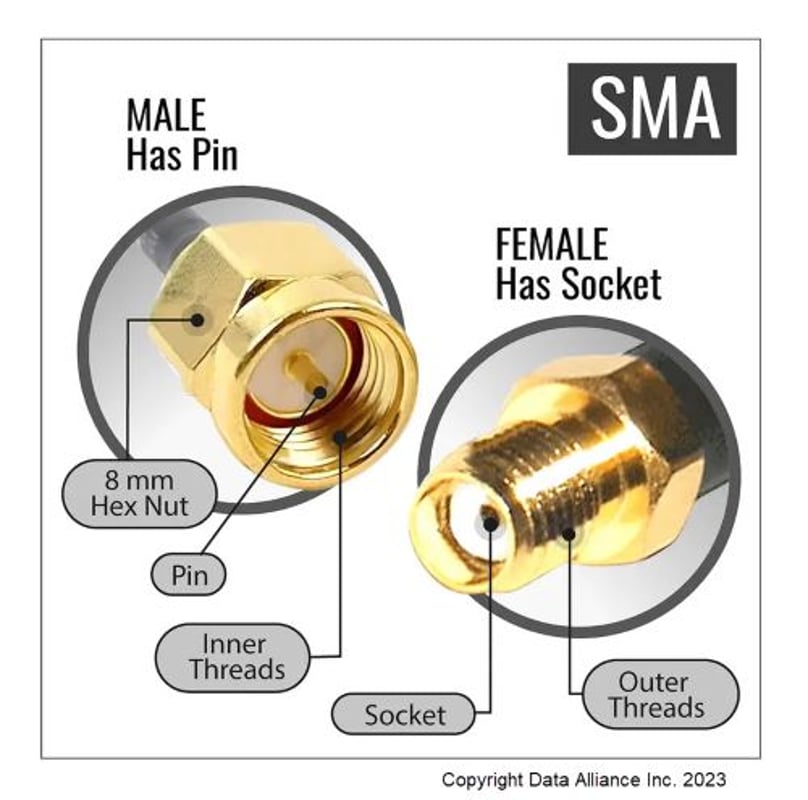
Applications of SMA Extension Cables:
SMA extension cables are used to place an antenna in an advantageous position to magnify signal strength with better line of sight. This often means placing an antenna higher, often outdoors, such as on a roof.
The sub-miniature size of SMA connectors, and an operating frequency range of 0 to 18 GHz, lends itself to a variety of RF, VHF, UHF and microwave applications. Highly versatile, they are used as antenna cables in telecommunications for a range of antenna classes. From domestic settings like homes and offices to vast industrial landscapes, the applications of SMA extension cables are manifold.
Key applications of SMA extension cables include:
- Cellular networking: GSM, CDMA, 4G/LTE, 5G
- Wi-Fi
- GPS
- Ham radio
- Satellite and radio astronomy
- Testing and measurement
- LNAs and other radio frequency power amplifiers
- RF isolators
- Radio communication boards
- PCBs
IoT Applications & Wireless Technologies used with SMA Male to Female Cables:
IoT (Internet of Things) is a burgeoning realm, encompassing devices that communicate and share data. SMA extension cables are often used in IoT applications.
- Extended Reach: Enabling devices located further apart to communicate seamlessly.
- Reduced Signal Loss: Ensuring data transmission remains robust.
- Versatility: Their compatibility with a wide array of wireless technologies ensures they can cater to diverse IoT devices.
- Hand-held Radio: SMAs are used in Ham radio. They can connect devices such as walkie-talkies to antennas for greater gain and performance. It is also a type of connector used by many DAB aerials.
- Mobile Antennas: A wide range of mobile antennas, particularly magnetic-mounted varieties, are available which feature the SMA connector. The male SMA connector is typically located on the antenna side with the female on the hardware side.
- WiFi: SMA connectors are widely used in WiFi equipment. RP-SMAs were particularly favored to preclude consumer use of antennas which could breach compliance.

